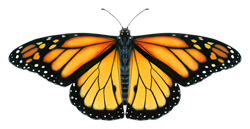| Welcome to our Monarch Butterfly Resources page. Here you will find articles on monarch butterflies and their migration, as well as numerous links to monarch conservation organizations and citizen science projects. |
| Links |
| Citizen Scientists |
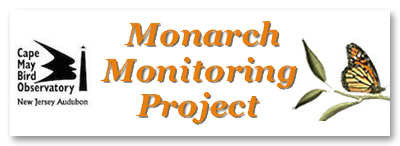 |
Cape May Bird Observatory Monarch Monitoring Project
The Monarch Monitoring Project (MMP), established in 1990, is a research and education program focusing on the fall migration of monarch butterflies along the Atlantic coast. For over two decades the MMP has gathered data on monarchs moving through Cape May during September and October. MMP staff and volunteers also conduct informational programs on monarch biology and tagging. More... |
 |
Journey North
In a unique partnership, you can join students and scientists across North America every spring to track the monarch butterfly's migration from Mexico. More... |
 |
Monarch Alert
Monarch Alert is a citizen based research project backed by graduate student researchers and faculty from Cal Poly State University, San Luis Obispo. Monarch Alert focuses on the demography and population fluctuations of western monarch butterflies, through sampling of overwintering populations in San Luis Obispo and Monterey Counties. More... |
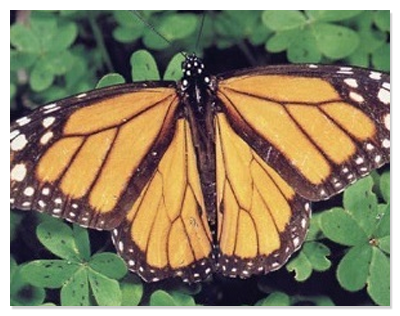 |
Monarch Dunes Butterfly Habitat
Learn about the history of the Monarch Dunes Butterfly Habitat, its status, and the work of the volunteers who manage it. More... |
 |
Monarch Joint Venture: Citizen Scientist Opportunities
Monarch Joint Venture works with citizen scientists to gather information about the status of monarch breeding and migration. More... |
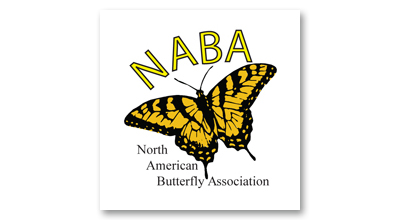 |
North American Butterfly Association Butterfly Garden and Habitat Program
NABA's Butterfly Garden and Habitat Program can
help you create a paradise for butterflies while encouraging habitat restoration, no matter the size of your area. More... |
 |
Project Monarch Health
Project Monarch Health is a citizen science project to track the prevalence of the protozoan parasite Ophryocystis elektroscirrha (OE) in monarch butterflies. To check for OE in monarchs, citizen scientists can first obtain wild adult monarchs by either catching them or rearing caterpillars until they become adults. Second, citizen scientists can press a clear sticker against each monarchs' abdomen to collect any parasites. Monarchs are then released, totally unharmed. Finally, citizen scientists send samples to our lab at the University of Georgia, where we count OE parasites using a microscope. We share results with volunteers and later report these data online or in published scientific articles. More... |
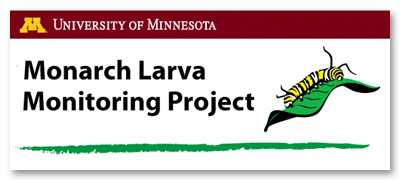 |
University of Minnesota Monarch Larva Monitoring Project
The Monarch Larva Monitoring Project is a citizen science project involving volunteers from across the United States and Canada who collect long-term data on larval monarch populations and milkweed habitat. The overarching goal of the project is to better understand how and why monarch populations vary in time and space, with a focus on monarch distribution and abundance during the breeding season in North America. More... |
 |
Monarch Watch Monarch Waystations Program
Create "Monarch Waystations" (monarch habitats) in home gardens, at schools, businesses, parks, zoos, nature centers, along roadsides, and on other unused plots of land. Without a major effort to restore milkweeds to as many locations as possible, the monarch population is certain to decline to extremely low levels. More... |
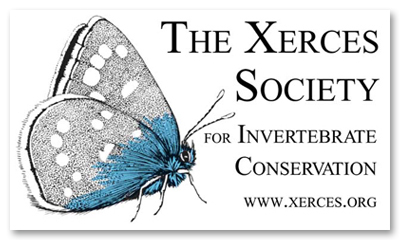 |
The Xerces Society Western Monarch Thanksgiving Count
The Western Monarch Thanksgiving Count is a yearly effort of volunteer citizen monitors to collect data on the status of monarch populations overwintering along the California coast. More... |
| Conservation |
|
 |
Monarch Joint Venture
The Monarch Joint Venture (MJV) is a partnership of federal and state agencies, non-governmental organizations, and academic programs that are working together to support and coordinate efforts to protect the monarch migration across the lower 48 United States. More... |
 |
Monarch Watch
Monarch Watch is a nonprofit education, conservation, and research program based at the University of Kansas that focuses on the monarch butterfly, its habitat, and its spectacular fall migration. More... |
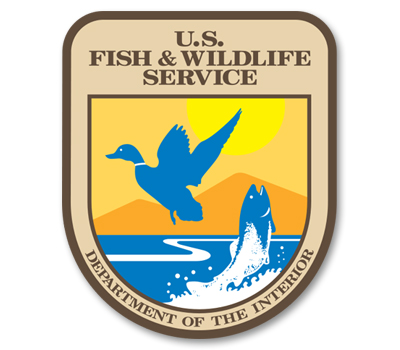 |
U.S. Fish and Wildlife
The U.S. Fish and Wildlife Service National Wildlife Refuge System participates in both Wildlife Without Borders, a program to conserve the natural wealth we share with Mexico, and the Monarch Joint Venture (MJV). More... |
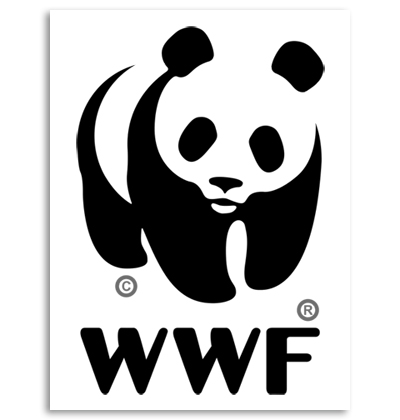 |
World Wildlife Fund
WWF works to preserve vital butterfly habitat in Mexico’s Monarch Butterfly Reserve by promoting good forest management and sustainable tourism. WWF also supports tree nurseries that help restore the forest in the Reserve which creates new sources of income for the local communities that live among the butterflies. More... |
 |
The Xerces Society
The Xerces Society is a nonprofit organization that protects wildlife through the conservation of invertebrates and their habitat. Xerces works with multiple partners across North America to conserve the monarch and its habitat. More... |
| Articles |
| Monarchs at Risk |
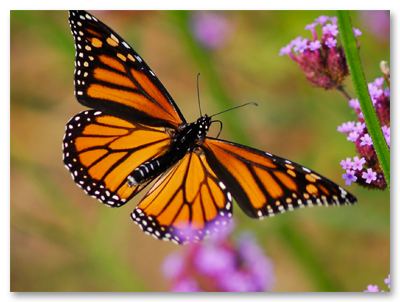 |
U.S. government pledges $3.2 million to save monarch butterfly
By Dina Cappeilo
The federal government on Monday pledged $3.2 million to help save the monarch butterfly, the iconic orange-and-black butterfly that can migrate thousands of miles between the U.S. and Mexico each year. In recent years, the species has experienced a 90 percent decline in population, with the lowest recorded population occurring in 2013-2014. More...
Photo by Dwight Sipler |
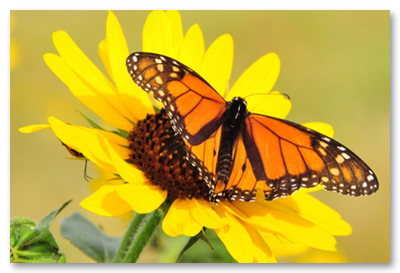
|
The monarch massacre: Nearly a billion butterflies have vanished
By Darryl Fears
Threatened animals like elephants, porpoises and lions grab all the headlines, but what's happening to monarch butterflies is nothing short of a massacre. The U.S. Fish and Wildlife Service summed it up in just one grim statistic on Monday: Since 1990, about 970 million have vanished. More...
Photo by Tom Koerner/USFWS |
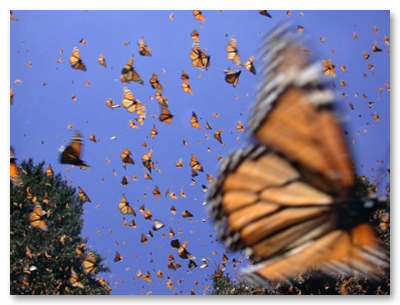 |
Tracking the Causes of Sharp Decline of the Monarch Butterfly
By Richard Conniff
A new census found this winter’s population of North American monarch butterflies in Mexico was at the lowest level ever measured. Insect ecologist Orley Taylor talks to Yale Environment 360 about how the planting of genetically modified crops and the resulting use of herbicides has contributed to the monarchs’ decline. More...
Photo by Jim Lovett/Monarch Watch |
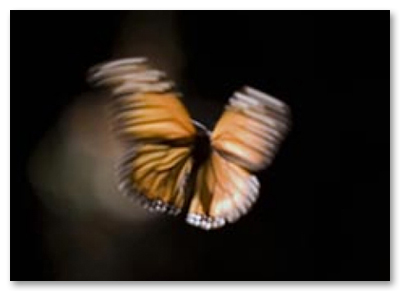 |
The Missing Monarchs
By Warren Cornwall
Feeding on a weed seems like a good evolutionary bet. And for a long time, it worked well for the monarch butterfly. The butterfly's life cycle is exquisitely synchronized to the seasonal growth of milkweed, the only plant its larvae will eat. In a game of hopscotch, successive generations of monarchs follow the springtime emergence of milkweed from Mexico as far north as Canada. The hardy plant once flourished in grasslands, roadsides, abandoned lots, and cornfields across much of the continent. It fueled a mass migration that ended each winter with more than 60 million butterflies converging on pine forests in the Sierra Madres. Then came Roundup. More...
Photo by Mario Vazquez/AFP/Getty Images |
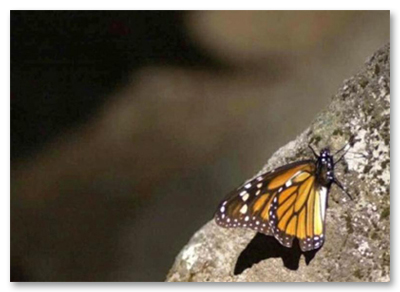 |
Why monarch butterflies are dying in record numbers
By Ryu Spaeth
This week, scientists reported that the monarch butterfly population in Mexico this winter fell to its lowest level in two decades, an alarming trend that could spell disaster for the familiar orange-and-black insects, which every year make a round-trip migration from Mexico to Canada. More...
Photo by Susana Gonzalez/Newsmakers |
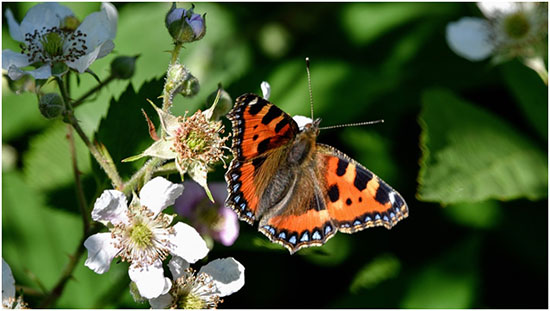 |
How to Build your own Butterfly Garden
I don't think there's a person alive who can't appreciate a garden full of lively butterflies. There's nothing quite like enjoying a summer day while watching More...
Photo by dpexcel/Pixabay
|
Monarch Migration |
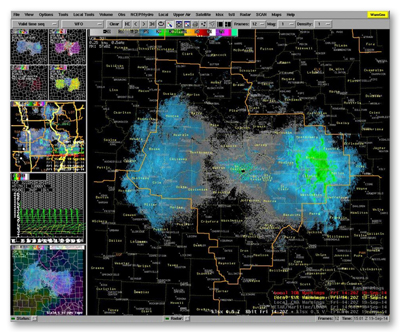 |
Mystery solved? Suspicious radar echoes were probably migrating Monarch butterflies
By Angela Fritz
The weather was beautiful in St. Louis, Mo. on Friday morning: 70 degrees and clear blue sky. Which is why forecasters were surprised by what they were seeing on their radar screens, which they now think were migrating Monarch butterflies. More...
Photo by NWS St. Louis |
 |
USDA Forest Service on Monarch Migration
The annual migration of North America’s monarch butterfly is a unique and amazing phenomenon. The monarch is the only butterfly known to make a two-way migration as birds do. Unlike other butterflies that can overwinter as larvae, pupae, or even as adults in some species, monarchs cannot survive the cold winters of northern climates. More... |
 |
Monarch Butterflies Migration Tracked Through Generations Across North America
Everyone knows all about the epic breeding journey taken each year by generations of monarch butterflies between Mexico and Canada, right? Not so fast, say researchers including University of Guelph biologists. More... |
| |
|
| |
